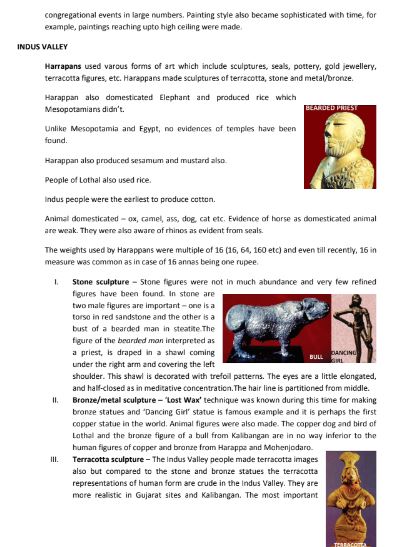‘Indian Art And Culture’ PDF Quick download link is given at the bottom of this article. You can see the PDF demo, size of the PDF, page numbers, and direct download Free PDF of ‘Indian Culture And Art’ using the download button.
Indian Art and Culture GK Notes PDF Free Download

Indian Art And Culture
CULTURE
Culture is a way of life. Culture is the embodiment of the way in which we think and do things.
It is also the things – tangible and intangible – that we have inherited as members of society.
All the achievements of human beings as members of social groups can be called culture.
Culture, thus, refers to a human-made environment which includes all the material and nonmaterial products of group life that are transmitted from one generation to the next.
India was earlier called Jamboodweepa and was called ‘India’ by Greeks for the first time as the ‘region beyond Sindhu’. Similarly, Arabs called Indians as ‘Hindus’ as they couldn’t pronounce ‘S’ in Sindhu.
The religion of Aryans who lived there in 1000 BCE was called Brahminism and not Hinduism.
Islam and Hinduism existed peacefully for 700 years and the first Muslims came to India in form of merchants on the Malabar Coast.
A BRIEF HISTORY of CULTURE
Indus Valley was the cradle of early civilization and culture because the place has features which made it conducive for early settlers.
Rainfall from Indus to Brahmputra plains gradually increases from 25cm to 250 cm and this was also the reason that vegetations in low rainfall regions were easier to clear to pave way for the cultivation.
So, the Indus valley came into being in the Indus area, Vedic civilisation in the Gangetic plain, Guptas spread further towards the east and in the medieval periods, the Assam plains also became important.
Rivers in ancient India served as arteries for carrying goods easily.
They also provided fertile land and most importantly acted as boundaries for political and cultural groups.
EARLY ROCK PAINTINGS
Earliest examples of the art and paintings are found in pre-historic works in caves and on rocks.
Rock paintings at Bhimbhethka in Madhya Pradesh are the most important among them which themselves belong to the larger Vindhya and Kaimur group findings.
In Bhimbhetaka, near Bhopal, there are more than 500 hundred rock shelters with paintings making them the richest site in India.
The cave paintings of Narsinghgarh (Maharashtra) show skins of spotted deer left drying.
In Uttarakhand also, rock paintings on the banks of river Suyal at Lakhudiyar (meaning lakh caves) have been found.
Here three types of figures are shown – man, animals and geometric figures.
Hand-linked dancing figures are famous among them.
Though artists during this period used many colours, white and red were their favourites.
Scenes from hunting, dancing etc. are shown in these paintings.
Earliest paintings have been identified in three periods, out of which, the one belonging to the Mesolithic period or the middle period is the largest.
In the last period, the painters were probably settled in agricultural communities and hence, their paintings also depict.
congregational events in large numbers.
Painting style also became sophisticated with time, for example, paintings reaching up to a high ceiling were made.
INDUS VALLEY
Harrapans used various forms of art which include sculptures, seals, pottery, gold jewellery, terracotta figures, etc. Harappans made sculptures of terracotta, stone and metal/bronze.
Harappan also domesticated elephants and produced rice which Mesopotamians didn’t.
Unlike Mesopotamia and Egypt, no evidence of temples has been found.
Harappan also produced sesamum and mustard also.
People of Lothal also used rice.
Indus people were the earliest to produce cotton.
Animal domesticated – ox, camel, ass, dog, cat etc.
Evidence of horses as domesticated animals is weak.
They were also aware of rhinos as evident from seals.
The weights used by Harappans were multiple of 16 (16, 64, 160 etc) and even recently, 16 in measure was common as in the case of 16 annas being one rupee.
I. Stone sculpture – Stone figures was not in much abundance and very few refined figures have been found.
In stone two male figures are important – one is a torso in red sandstone and the other is a bust of a bearded man in steatite.
The figure of the bearded man interpreted as a priest is draped in a shawl coming under the right arm and covering the left shoulder.
This shawl is decorated with trefoil patterns.
The eyes are a little elongated, and half-closed as in meditative concentration.
The hairline is partitioned from the middle.
II. Bronze/metal sculpture – ‘Lost Wax’ technique was known during this time for making bronze statues and the ‘Dancing Girl’ statue is a famous example and it is perhaps the first copper statue in the world.
Animal figures were also made.
The copper dog and bird of Lothal and the bronze figure of a bull from Kalibangan are in no way inferior to the
human figures of copper and bronze from Harappa and Mohenjodaro.
III. Terracotta sculpture – The Indus Valley people made terracotta images also but compared to the stone and bronze statues the terracotta representations of the human form are crude in the Indus Valley.
They are more realistic in Gujarat sites and Kalibangan. The most important
| Author | – |
| Language | English |
| No. of Pages | 204 |
| PDF Size | 10 MB |
| Category | History |
| Source/Credits | drive.google.com |
Related PDFs
Tamil Nadu Board History Class 11 PDF
Indian Art and Culture GK Notes PDF Free Download
